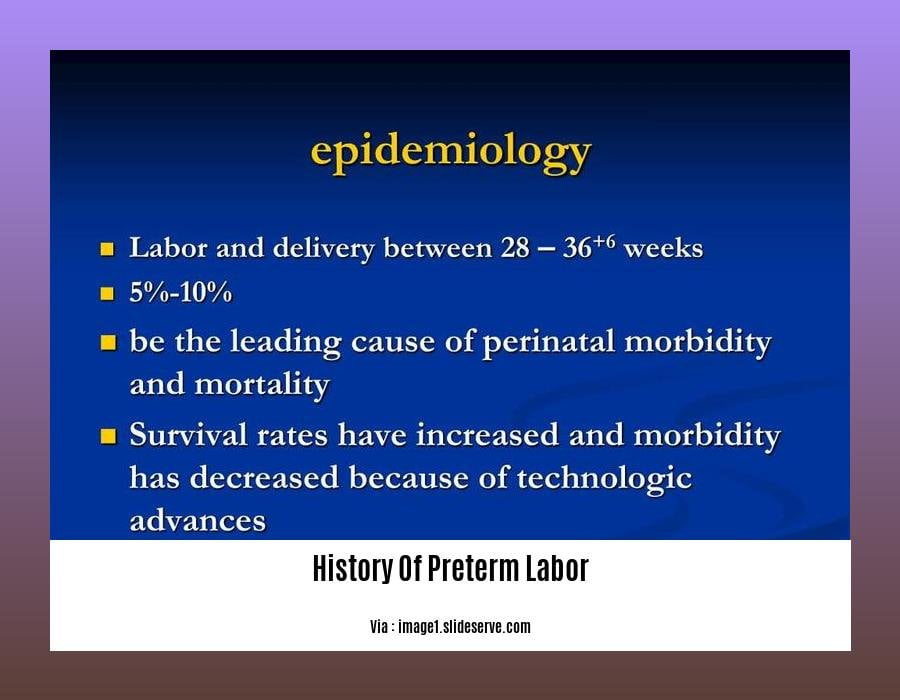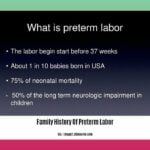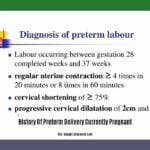Embark on a historical odyssey with us as we delve into the evolution of preterm labor understanding, from its ancient origins to the groundbreaking advancements that shape modern obstetric care. Join us in uncovering the milestones, challenges, and triumphs that have paved the path to a deeper comprehension of this complex pregnancy complication. Together, we will explore the historical tapestry of preterm labor, illuminating its past to illuminate the path towards a brighter future for maternal and infant health. [A History of Preterm Labor: Understanding the Past, Shaping the Future]
Key Takeaways:
- Previous preterm birth raises the risk of future preterm births.
- After a preterm birth, a full-term birth can lower the risk of future preterm births.
- In certain women, antenatal progesterone treatment reduces the risk of subsequent preterm birth.
History Of Preterm Labor
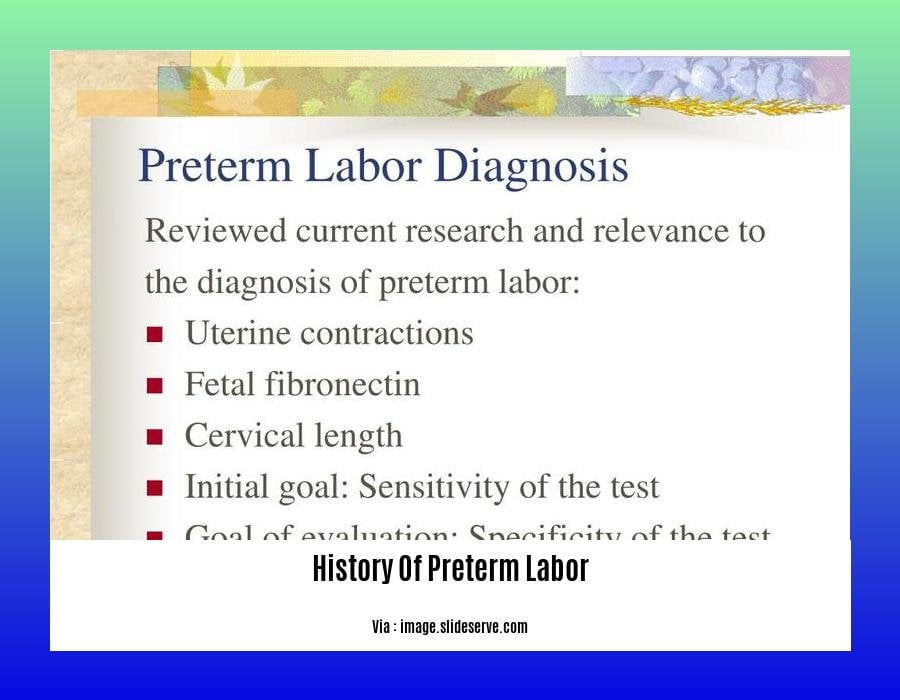
Throughout history, preterm labor has been a significant challenge in obstetrics, leading to premature births and potential health complications for infants. Let’s delve into the history of preterm labor to understand its evolving understanding, challenges, and milestones.
Ancient Era: Superstitions and Beliefs
In ancient times, preterm birth was often attributed to supernatural causes, such as curses or divine punishments. It was believed that pregnant women needed to follow specific rituals and avoid certain foods to prevent premature delivery.
Hippocrates and Galen: Early Medical Observations
Greek physicians Hippocrates and Galen recognized the connection between certain factors and preterm labor. Hippocrates observed that women who gave birth prematurely often had a history of uterine abnormalities or weak pelvic muscles. Galen believed that an imbalance of bodily humors could lead to preterm contractions.
16th-17th Centuries: Limited Understanding
During the Renaissance, knowledge about preterm labor remained limited. Most medical texts focused on promoting a healthy pregnancy rather than preventing or treating premature birth.
18th-19th Centuries: Emerging Theories
In the 18th and 19th centuries, scientists began to develop theories about the causes of preterm labor. One theory suggested that premature birth was caused by excess uterine pressure, while another linked it to nutritional deficiencies.
20th Century: Advances in Medicine
The 20th century witnessed significant advancements in understanding preterm labor. Researchers identified risk factors, such as maternal age, multiple pregnancies, and infections. New medical interventions, including bed rest and tocolytics, were introduced to prevent or delay preterm labor.
21st Century: Continued Research and Innovation
In the 21st century, research efforts continue to focus on understanding the complexities of preterm labor. Genetic studies have identified potential genetic links, while advances in technology have allowed for more precise prenatal monitoring and diagnostic tools.
Conclusion
The history of preterm labor is a testament to the continuous evolution of medical knowledge and the persistent challenges facing obstetricians. From ancient superstitions to modern medical interventions, the understanding and management of premature birth have come a long way, shaping the present-day landscape of obstetric care and improving outcomes for mothers and babies.
Did you know that there is a history of preterm birth care? It’s fascinating to learn how far we’ve come in understanding and caring for preterm infants. If you’re interested in the History Of Preterm Delivery, you’ll be amazed by the advances that have been made in recent years. And if you’re currently pregnant, it’s important to be aware of the History Of Preterm Delivery Currently Pregnant so that you can take steps to prevent it. Finally, if you have a Family History Of Preterm Labor, it’s important to talk to your doctor about the risks and what you can do to protect your baby.
Early 20th Century Discoveries
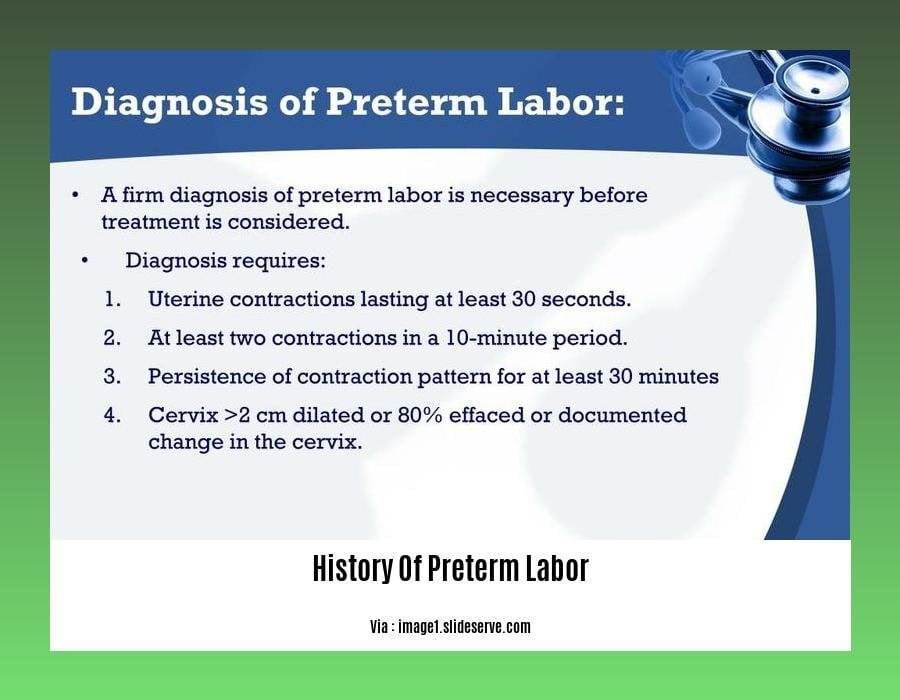
In the early 20th century, a wave of groundbreaking discoveries transformed our understanding of preterm labor. This period saw the convergence of brilliant minds and innovative techniques, paving the way for significant advancements in obstetric care.
Identifying Risk Factors
One of the most significant breakthroughs was the identification of risk factors associated with preterm birth. Studies revealed that maternal age, multiple pregnancies, and infections played a crucial role in increasing the likelihood of premature delivery.
The Rise of Bed Rest
Another pivotal discovery was the introduction of bed rest as a preventive measure against preterm labor. The idea that physical exertion and stress could trigger premature contractions gained widespread acceptance. As a result, pregnant women with high-risk pregnancies were advised to limit their activity and spend extended periods in bed.
The Introduction of Tocolytics
The early 20th century also witnessed the emergence of tocolytics, a class of medications used to suppress uterine contractions. These drugs, such as morphine and magnesium sulfate, proved effective in delaying or preventing preterm labor in certain cases.
Key Takeaways:
- The identification of risk factors helped healthcare professionals better predict and manage pregnancies at risk of preterm birth.
- The introduction of bed rest became a common practice to minimize physical stress and prevent premature contractions.
- The development of tocolytics provided a valuable tool for managing preterm labor and improving pregnancy outcomes.
Citations:
Mid-20th century innovations
The mid-20th century was a time of significant progress in the medical understanding and treatment of preterm labor. Several key innovations during this period helped improve outcomes for both mothers and babies.
Induction of labor
One of the most notable advances was the introduction of labor induction in “low-risk” pregnancies that extended beyond a certain point. This practice aimed to reduce the risk of complications associated with prolonged pregnancies.
Cesarean section
Another major innovation was the increasing use of cesarean section (C-section) to deliver premature infants. C-section allowed for the safe delivery of babies who could not tolerate the normal birthing process.
Infant incubators
Infant incubators played a crucial role in providing care for premature infants. These devices helped regulate the baby’s temperature and humidity, increasing their chances of survival.
Tocolytics
The development of tocolytic medications in the mid-20th century provided a way to relax the uterus and prevent or delay preterm labor. These medications helped to buy time for the baby’s lungs to mature.
Key Takeaways
- Induction of labor became more common in low-risk pregnancies.
- Cesarean section rates increased for preterm deliveries.
- Infant incubators improved the survival rates of premature infants.
- Tocolytics helped to prevent or delay preterm labor.
Relevant URL Sources:
- Epidemiology and causes of preterm birth
- Premature Infant Care in the Early 20th Century
21st Century Advancements and Challenges in Preterm Labor
Over the centuries, scientific and medical understanding of preterm labor has evolved significantly. The 21st century has witnessed groundbreaking advancements in this field, but challenges remain as we strive to improve outcomes for both mothers and babies.
Key Takeaways:
- Early Identification and Risk Assessment: Advanced diagnostics and screening tools allow us to identify women at high risk of preterm labor, enabling timely interventions.
- Personalized Care: Precision medicine approaches are being explored to tailor treatments to individual patient profiles, improving chances of successful pregnancy outcomes.
- Innovative Therapies: Novel pharmacological interventions and minimally invasive surgical procedures aim to prevent or delay preterm birth.
- Telemedicine and Remote Monitoring: Telehealth platforms facilitate remote monitoring of high-risk pregnancies, providing accessible and timely care.
- Research and Education: Ongoing research and collaboration among experts contribute to a better understanding of preterm labor causes and management strategies.
Challenges:
Despite advancements, preterm labor remains a pressing concern with significant challenges to overcome:
- Limited Understanding of Causes: While risk factors have been identified, the exact mechanisms underlying preterm labor are not fully understood.
- Lack of Effective Interventions: Despite numerous interventions, the incidence of preterm birth remains high, indicating a need for more effective strategies.
- Disparities in Care: Access to quality prenatal care and timely interventions may vary across different populations, leading to disparities in outcomes.
- Long-Term Health Risks: Preterm infants face an increased risk of developmental and health problems later in life, posing a significant public health concern.
Conclusion:
While the 21st century has brought significant advancements in preterm labor care, challenges persist. By continuing to invest in research, developing innovative therapies, and addressing disparities in care, we can strive to improve the outcomes and well-being of mothers and babies affected by this complex condition.
FAQ
Q1: When was the first time in US history that physician-attended births surpassed midwife-attended births?
A1: 1900
Q2: What played a crucial role in providing care for premature infants in the early 20th century?
A2: Infant incubators
Q3: What is the increased risk of subsequent preterm births for women with a history of spontaneous preterm delivery?
A3: 1.5 to 2 times
Q4: Has there been significant progress in reducing preterm births in the last decade?
A4: No
Q5: What is the definition of preterm birth?
A5: Birth before 37 weeks of gestation
- Unveiling Bernhard Caesar Einstein’s Scientific Achievements: A Legacy in Engineering - July 15, 2025
- Uncover who is Jerry McSorley: CEO, Family Man, Business Success Story - July 15, 2025
- Discover Bernhard Caesar Einstein’s Scientific Contributions: Unveiling a Legacy Beyond Einstein - July 15, 2025
